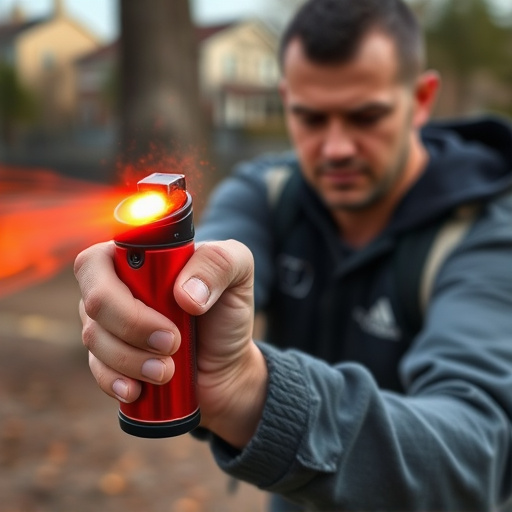After pepper spray exposure, immediate home decontamination is crucial for safety. Remove contaminated clothing, rinse affected areas with warm water, and ventilate the space. Clean hard surfaces with mild soap, vacuum carpets, and avoid harsh chemicals. Prepare essential tools like eye washes, bandages, and cleaning agents. Follow structured steps: wash eyes for 15 minutes, seek medical advice if needed, and thoroughly clean all contaminated items.
Personal security is a paramount concern in today’s world, and one of the most effective tools for self-defense against threats is pepper spray. This article explores the vital role of pepper spray in personal security, focusing on decontaminating after exposure at home using simple, yet effective steps. We’ll guide you through understanding pepper spray, essential decontamination practices, and safety measures to ensure your well-being. Learn the crucial decontamination steps for a swift return to safety following pepper spray exposure.
- Understanding Pepper Spray: Its Role in Personal Security
- Decontaminating After Exposure to Pepper Spray at Home
- Essential Tools and Materials for Effective Decontamination
- Safety Measures and Best Practices for Handling Pepper Spray
Understanding Pepper Spray: Its Role in Personal Security
Pepper spray, a common personal security product, is designed to incapacitate an attacker temporarily, giving users precious time to escape or defend themselves. It works by irritating the eyes and respiratory system, causing temporary blindness and difficulty breathing. This non-lethal force option is widely used by law enforcement and civilians alike for self-defense purposes.
Understanding how to properly decontaminate after exposure to pepper spray is crucial. At home, immediate steps include removing contaminated clothing and washing affected areas with warm water and mild soap. Taking a shower can help rinse away any remaining spray residue. Keeping eye washes and nasal irrigators nearby can aid in quick decontamination, especially for those who experience vision or breathing issues post-exposure. Regular cleaning and storing pepper spray safely is also essential to prevent accidental discharge and ensure its effectiveness when needed.
Decontaminating After Exposure to Pepper Spray at Home
After being exposed to pepper spray, decontaminating your home is crucial to ensure safety and prevent further irritation or potential health risks. Start by opening all windows and doors to allow fresh air circulation, as this will help dissipate the chemical residue. Wear protective clothing, including gloves, to avoid direct contact with contaminated surfaces.
Next, identify all areas affected by the pepper spray. Focus on high-touch surfaces like doorknobs, light switches, and countertops. Use a mixture of water and mild soap to clean these surfaces thoroughly. For hard floors, use a damp mop; for carpets or upholstery, vacuum immediately after to capture any remaining pepper spray particles. Remember, proper decontaminating steps at home are essential to maintain a safe living environment after exposure to pepper spray.
Essential Tools and Materials for Effective Decontamination
When it comes to personal security and inflammatory defense, having the right tools for decontamination is paramount. Pepper spray, a widely recognized self-defense product, also serves as an effective means of neutralizing potential threats. For comprehensive decontamination steps at home, start with essential materials like eye wash solutions, bandages, and cleaning agents suitable for removing chemical residues. These items ensure thorough cleaning and protection against unwanted substances.
Proper decontamination involves a series of structured actions. Begin by evacuating the area and ensuring good ventilation. Then, quickly deploy pepper spray to disable the aggressor while taking necessary precautions to avoid cross-contamination. Afterward, follow recommended decontamination steps: wash eyes and face with plenty of water for at least 15 minutes, seek medical attention if needed, and thoroughly clean all surfaces and items that may have come into contact with the irritant.
Safety Measures and Best Practices for Handling Pepper Spray
When handling pepper spray, safety is paramount. After exposure or use, it’s crucial to follow immediate decontamination steps at home to prevent any adverse effects. Start by removing any contaminated clothing or shoes, taking special care not to rub your eyes or touch your face. Rinse affected areas with plenty of water for at least 15 minutes, ensuring thorough cleaning.
For pepper spray decontamination steps at home, create a safe space away from others and seal off the area if possible. Use soap and warm water to thoroughly wash your hands and body after any interaction. Avoid using harsh chemicals or alcohol-based products as they may exacerbate irritation. Lastly, ensure proper ventilation throughout the process and for several hours afterward.
In conclusion, pepper spray is a powerful personal security tool, but proper decontamination steps at home are essential after exposure. By understanding how to safely handle and decontaminate this defense product, individuals can ensure their well-being and maintain a clean environment. Following the recommended decontamination procedures outlined in this article, along with keeping essential tools readily available, will help you stay protected and prepared.
